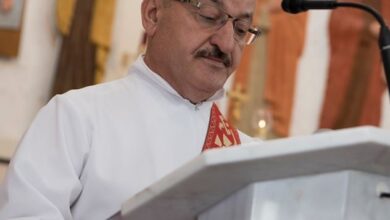The Church of the east, Major persecution
A Brief History of the Church of the East, Major Persecutions
The Church of the East traced its origins ultimately to the evangelical activity of the Apostles; St. Thomas, Mar Addai and Mar Mari. In the third century, the bishop of the diocese of Seleucia-Ctesiphon, near Baghdad, came to be recognized as Catholicos, Patriarch of the East. The church quickly spread widely through Asia. Between the 9th and 14th centuries, it was the world’s largest Christian church in terms of geographical extent, with dioceses stretching from the Mediterranean & Cyprus to China, Tibet and India.
Christians were already forming communities in Mesopotamia as early as the first century, when it was part of the Persian Empire. Until the beginning of 4th century, the church of the east was living in calm & peace. However, due to Persian-Roman conflict, the Church faced several & severe persecutions, mainly during the reign of king Shapur II (339–379) who accused the church of its leanings towards Christian Roman Empire. This severe persecution lasted 40 years. Thousands of Christians were beheaded including the Patriarch Catholicos, Mar Shemon Bar Sabba’e and his clergy. The second major persecution occurred, during the reign of Persian King Khosrau the first; this ended in 545. Due to hundred thousands of martyrs, the church of the east was named; the church of the martyrs.
The church survived these trials under the guidance of the Holy Spirit, and the prayers of the faithfuls. It emerged from the persecutions, a robust in its faith and principles. When the Persian Empire fell to the hands of Muslim Arabs in 644, almost half of the Persian territory populations were Christians.
After the Persian Empire was conquered by Muslim Arabs, the newly established Ra’shidun Caliphate and afterwards Umayyad & Abbasid Caliphate, designated the Church of the East as an official dhimmi minority group, headed by the Patriarch of the East. The Church was restricted within the Caliphate, and its followers were treated as; a second class citizens, by putting distinguishing signs on them, like wearing different style of clothes, haircuts etc. Hence, Christians made substantial contributions to the Islamic Umayyad and Abbasid Caliphates, particularly in translating the works of the ancient Greek philosophers to Aramaic and Arabic.
Patriarch Timothy the great (780-823)-who transferred the Patriarchal See to the capital Baghdad- and his successors, sent missionaries to middle Asia, India and China. Several Mongol tribes converted to Christianity. Between 9th to 14th centuries, the number of Metropolitan provinces of the church were more than 30, with over 200 dioceses, and an estimated of 80-100 millions of its followers.
From its peak of geographical extent, the church experienced a rapid period of decline starting in the 14th century. The Mongol Empire dissolved into civil war, and it reached a turning point in 1295, when Ghazan, the supreme Mongol ruler, made a formal conversion to Islam. The Muslim Mongol leader Timurlane (1336–1405) nearly eradicated the Christians in Asia, Persia and south Mesopotamia. He also destroyed many bishoprics and churches; thereafter, Christianity was largely confined to Upper Mesopotamia in the mountains of Kurdistan, with just ½ a million faithfuls.
The patriarchal See was moved to the monastery of Rabban Hormizd in Alqosh’s mountain, near Mosul city. In 1450, Patriarch Mar Shimun Basidi established a new, hereditary, line of patriarchal succession. In 1551, large number of church followers, including three bishops, opposed this arrangement. They elected a new patriarch, a monk named Yohannan Sulaqa, the superior of Rabban Hormizd Monastery. Sulaqa was sent to Rome in 1552 and was consecrated a bishop, recognized as Patriarch for the Chaldeans in St. Peter Basilica, and received the Pallium from the pope Julius hands. Upon his return to East, Sulaqa was invited by the governor of Amadiya (north Iraq), who imprisoned him for four months, tortured him and put him to death in January 1555. He was named the martyr of the union, with the Roman Catholic Church.
The Church of the East went into a schism, from which, two distinct churches eventually emerged: the Chaldean Catholic Church and Assyrian Church of the East.
In 1743, Nader shah from Persia, best known as Tohmaseb, idolized Timurlane. He imitated his military style and his cruelty. He conquered upper Mesopotamia’s cities and villages, Kirkuk, Erbil, Mosul and surrounding villages, killing thousands of Christians and other minority groups, and destroying many churches and Monasteries.
In 1844, the Massacres of Bader Khan, the prince of Bohtan in Turkey, were a series of massacres carried out, against Assyrian & Chaldean Christians. The massacres resulted in the killing of more than 10,000 Christians and the captivity of thousands of others.
In 1915, the both branches of the Church of the east, the Syrian & the Armenian Church in Turkey, were completely destroyed by the Ottoman Turkish Empire, the massacres were so horrible, thousands of Armenians, Chaldeans, Syrians and Assyrian were tortured and killed, including Mar Benjamin, the Patriarch of the Assyrian church and three Chaldean Catholic bishops. Survivors of these massacres escaped, by marching over the mountains into Iraq, Iran and Syria.
Two months ago, ISIS, the Islamic State in Iraq and Syria fighters, controlled Mosul city, and afterwards, the surrounding villages and towns, forcing more than 100, 000 Christian, mainly Chaldeans & Syrians, to abandon their villages & flee for their lives, to Kurdish controlled area. Children and families have fled their homes, often in the middle of the night with nothing, but the clothes on their backs. They don’t know if their lives will ever be the same again.”
They desperately need our prayers and support. Let us join the Holy Father, Pope Francis, and other Christian leaders, to pray to the Lord, for their safety. Virgin Mary, queen of peace, give us peace. Amen.
Sami Desho-Australia


